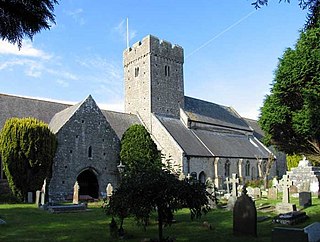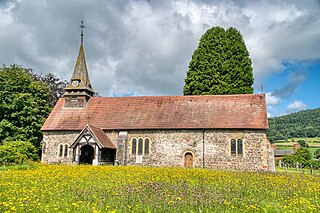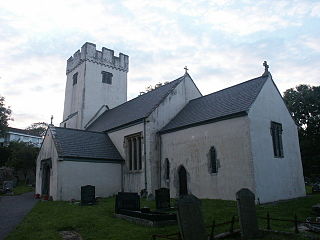
Llansantffraed (Llansantffraed-juxta-Usk) is a parish in the community of Talybont-on-Usk in Powys, Wales, near Brecon. The benefice of Llansantffraed with Llanrhystud and Llanddeiniol falls within the Diocese of St Davids in the Church in Wales.

Ewenny Priory, in Ewenny in the Vale of Glamorgan, Wales, was a monastery of the Benedictine order, founded in the 12th century. The priory was unusual in having extensive military-style defences and in its state of preservation; the architectural historian John Newman described it as “the most complete and impressive Norman ecclesiastical building in Glamorgan”. Following the Dissolution of the Monasteries, parts of the priory were converted into a private house by Sir Edward Carne, a lawyer and diplomat. This Elizabethan house was demolished between 1803 and 1805 and replaced by a Georgian mansion, Ewenny Priory House. The house is still owned by the Turbervill family, descendants of Sir Edward. The priory is not open to the public apart from the Church of St Michael, the western part of the priory building, which continues to serve as the parish church for the village. The priory is in the care of Cadw and is a Grade I listed building.

Merthyr Mawr is a village and community in Bridgend, Wales. The village is about 2+1⁄2 miles from the centre of Bridgend town. The population of the community at the 2011 census was 267. The community occupies the area west of the Ewenny River, between Bridgend and Porthcawl. It takes in the settlement of Tythegston and a stretch of coastal sand dunes known as Merthyr Mawr Warren. It is in the historic county of Glamorgan.

St Illtyd's Church is a church complex in Llantwit Major, Vale of Glamorgan, southeast Wales. It is located at the site of the oldest college in the United Kingdom, once believed to have been founded as Côr Tewdws c. AD 395 by the Roman Emperor Theodosius II. It is now generally accepted as having been founded by St. Illtud c. AD 508, from whom it derives its name. The current church building was built in the 11th century by the Normans, with portions being rebuilt in the 13th and 15th centuries. The church building is one of the oldest and best-known parish churches in Wales. It is a grade I listed building, or building of exceptional interest, and has been called both the "Westminster Abbey of Wales" for its unique collection of carved stones and effigies, and "the most beautiful church in Wales."

Llanfair Dyffryn Clwyd is a village and community in Denbighshire, Wales, situated in the Vale of Clwyd about one mile south of the town of Ruthin. In the 2001 census, it had 1048 residents and 50.6% of them could speak Welsh. The figures for the 2011 census were: population 1,053; Welsh speakers 46.9%. The age group with the highest percentage of Welsh speakers was the 15-year-olds, all of whom could speak it. The villages of Pentrecelyn and Graig Fechan are located in the community.

Llanfechain is a village and community in Powys, Wales, on the B4393 road between Llanfyllin and Llansantffraid-ym-Mechain. Historically it belonged to Montgomeryshire. The River Cain runs through. The population of 465 at the 2011 Census was estimated at 476 in 2019.

John Prichard was a Welsh architect in the neo-Gothic style. As diocesan architect of Llandaff, he was involved in the building or restoration of many churches in south Wales.

St Garmon's Church, Llanfechain, is in the village of Llanfechain, Powys, Wales. It is an active Anglican parish church in the deanery of Llanfyllin, the archdeaconry of Montgomery, and the diocese of St Asaph, and is designated by Cadw as a Grade II* listed building. The church is traditionally associated with a 9th-century Celtic saint, St Garmon. St Garmon was most likely St Germanus (410–474), the first Bishop of Man. It shares it name with the church in the village of St Harmon in Radnorshire (Powys), where the diarist Francis Kilvert was a curate.

The Church of St Thomas the Martyr at Overmonnow, Monmouth, south east Wales, is located beside the medieval Monnow Bridge across the River Monnow. At least part of the building dates from around 1180, and it has a fine 12th-century Norman chancel arch, though the exterior was largely rebuilt in the early 19th century. It is one of 24 buildings on the Monmouth Heritage Trail and is a Grade II* listed building.

St Peter's Church is a Church of England parish church at Dixton in Wales. It is situated on the banks of the River Wye, about 1 mile (1.6 km) north-east of Monmouth, Wales. The church is a Grade II* listed building and the cross in the churchyard is both a listed building and a scheduled monument.

There are 33 Grade I listed buildings in the Vale of Glamorgan all of which are churches and priory buildings, castles, country or manor houses and associated structures such as churchyard crosses and a dovecote.

In the United Kingdom, the term listed building refers to a building or other structure officially designated as being of special architectural, historical, or cultural significance; Grade II* structures are those considered to be "particularly important buildings of more than special interest". Listing was begun by a provision in the Town and Country Planning Act 1947. Once listed, strict limitations are imposed on the modifications allowed to a building's structure or fittings. In Wales, the authority for listing under the Planning Act 1990 rests with Cadw.
Llantrithyd is a rural village and community in the Vale of Glamorgan, Wales. The Aubrey Baronets were lords of the manor of Llantrithyd for centuries: the family died out in the 1850s.

St Mellons Parish Church, also previously called St Melan's church, is a Church in Wales parish church in the Diocese of Monmouth in Old St Mellons, Cardiff, Wales. It was built around the 13th century and is a Grade I listed building.

St Stephen's Church is a Church of England parish church in Old Radnor, Powys, Wales. It was constructed in the 15th century in perpendicular gothic style on the site of a 6th-century church. It is a grade I listed building.

St Donat's Church is a Grade I listed church in St Donats, in the Vale of Glamorgan, south Wales. It became a Grade I listed building on 22 February 1963.

St Michael and All Angels Church is a Grade I listed church in Colwinston, in the Vale of Glamorgan, south Wales. It became a Grade I listed building on 22 February 1963. The church is said to have been built in 1111. The earliest mention of this parish church comes in the form of an 1141 confirmation of a donation made to the church by Maurice de Londres. The church and all of its possessions were given to the Abbey of Gloucester; this was confirmed circa 1200 when the Bishop of Landaff assigned a resident chaplain to the church. In 1254, the church was listed with a valuation of five marks. By 1291, it was combined with the valuation of Ewenny Priory.

The Church of St Andrew, Penrice, Swansea, Wales dates from the 12th century. A Grade II* listed building, St Andrew's remains an active parish church in the parish of South-West Gower, in the Diocese of Swansea and Brecon.

St Bilo's Church, is an active parish church in the village of Llanfilo, Felin-fach, Powys, Wales. The dedication is to Bilo, one of the 24 children of Brychan, a legendary 5th-century king of Brycheiniog. Dating from the 12th century, with later additions, the church was restored by W. D. Caröe in the early 20th century. St Bilo's is designated by Cadw as a Grade I listed building.

















